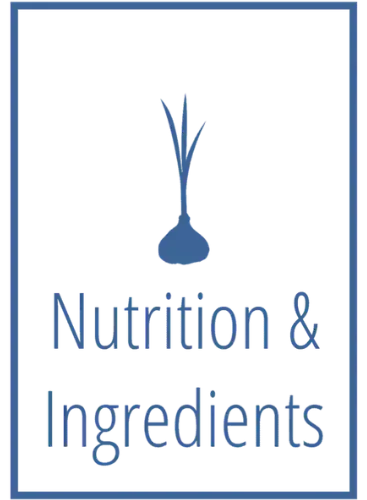Cream Cheese vs Butter: A Better Nutrition Comparison
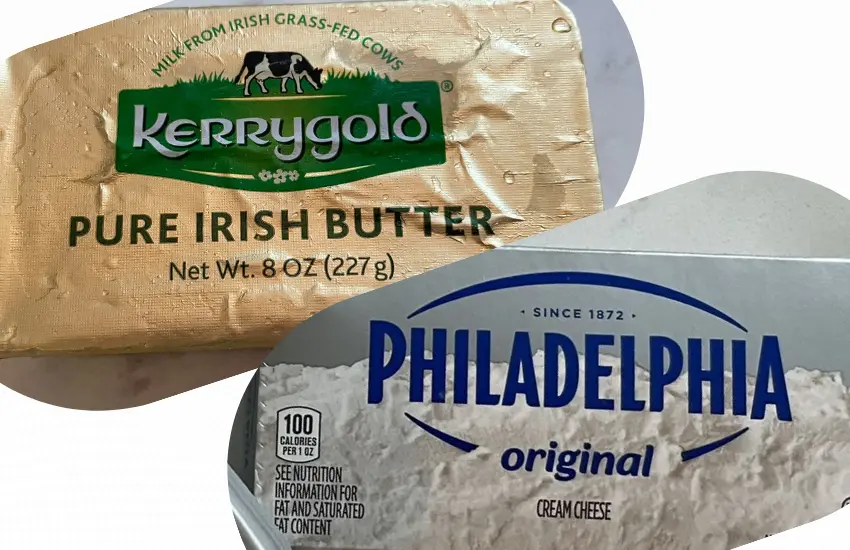
When consumers think of certain foods such as butter they may conjure up thoughts of a single ingredient. Butter is just butter. Unless it’s salted butter. But even then it’s basically just butter and salt. Right?
Well, what is butter? What’s the difference from one brand to the next?
Likewise, is cream cheese simply a softened cheese? Are there any similarities or major differences between butter and cream cheese? If so, which option is a better choice?
We answer all of those questions and more in this in-depth food guide.
By the end of this report, you will know enough about the calories, fat content, sodium levels, and other nutrients and ingredients to decide whether regular cream cheese, whipped cream cheese, salted butter, or fancy European butter is the best option for your next snack or meal.
Overview of Food Guide
Producers of commercially packaged foods are required to publish the measured serving size on nutrition facts labels.
The manufacturer’s standard serving size may be different from the actual portion sizes consumed at breakfast, lunch, or dinner. As part of a healthy diet, we recommend paying attention to not only the nutritional values and ingredients, but also the product serving sizes.
This report reviews the general nutritional values for cream cheese and butter based on a net weight of 1 ounce. Note that may be higher than the measured serving size printed on nutrition facts labels, but it ensures our analysis is grounded on comparable data.
Review of 6 Butter & Cream Cheese Products
In addition to general information sourced from the US FDA and USDA FoodData Central, Nutrition & Ingredients staff purchased butter and cream cheese products to conduct the review for this report.
Here is a list of the products included in this nutritional analysis report:
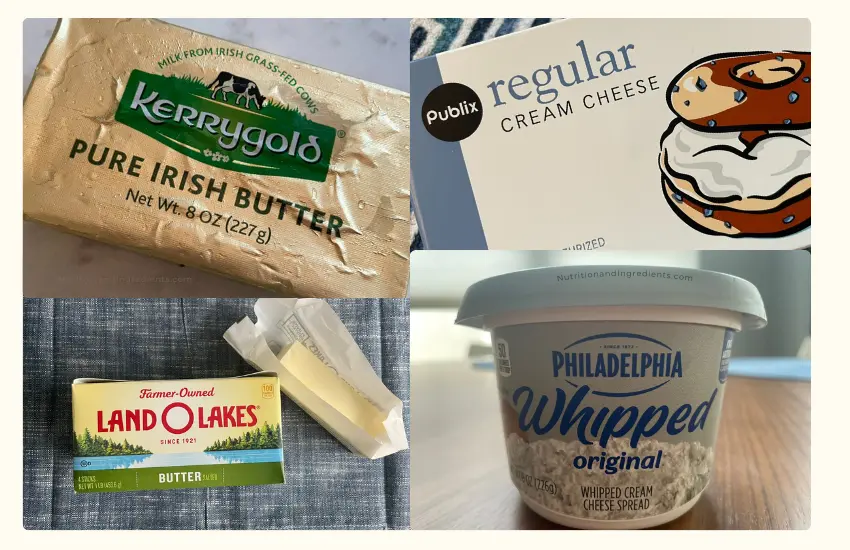
Butter and Cream Cheese Explained
These dairy-based products are made with cow’s milk and are used in many ways.
What is Butter?
Butter is the solid fat and protein components derived from fresh cream. The most common form of butter is made with cow’s milk. However, there are also plant-based butter products available in the market.
How is Butter Made?
The process of making butter is quite simple. Milk or cream is churned, which basically means it’s rapidly and repeatedly swirled and turned. The agitation forces the fat in the cream to separate from the liquid.
The solid fat that clumps together is butter. Salt may be added to improve preservation and enhance flavors.
How is Butter Used?
Although butter is a simple food product, it is extremely versatile.
Cooks use butter in countless ways, from a fresh stack of pancakes to pan fried sole. It’s a cornerstone ingredient in homemade sweet treats such as cookies and cakes, but also a key component for elevating flavors in steak and chicken entrees.
With a high fat content, butter has a smoke point of 302°F.
However, that’s lower than vegetable oils such as canola oil and olive oil, which have smoke points of up to 400 degrees Fahrenheit. Avocado oil has a staggeringly high smoke point of 520°F.
Because of the lower smoke point, butter is often used as a finishing oil rather than a cooking oil when searing food at high temperatures. For example, add a pat of butter as a final step after grilling a steak.
That said, butter may be the better option for pan frying foods such as shrimp that cook quickly at lower temperatures. Likewise, butter may be added to a pan-seared chicken entree or to create a roux for thickening soups or stews.
In addition, butter is used cold or at room temperature as a topping on breads, bagels, and muffins. Many restaurants enhance the flavor of butter with seasoning such as garlic, herbs, or salts.
Kerrygold’s Better Flavor Comes at a Cost
In our household, we refer to two types of butter: cooking butter and good butter. The latter is always Kerrygold. It’s our favorite.
The flavor of Kerrygold butter is creamier, deeper, and all around better tasting. Plugra labels itself a premium European style butter, but doesn’t deliver the same rich and creamy experience as Kerrygold.
But, if Plugra and Land O’ Lakes are the only options for topping a warm toasted bagel or stack of pancakes, reach for Plugra. There is no comparison. For a better taste, choose butter with a higher butterfat content.
However, the cost of Kerrygold is nearly twice that of Land O’ Lakes. That’s where the cooking butter comes into play. I’m not wasting Kerrygold on a searing hot griddle.
Land O’ Lakes butter is used for the pancake batter and the pan. Then the table is set with premium creamy Kerrygold for a pat of butter and maple syrup to garnish the hotcakes.

What is Cream Cheese?
Cream cheese is a smooth dairy-based spread with a creamy texture. It’s made with real cream and milk and generally contains other stabilizing ingredients such as guar gums or xanthan gum.
The extra additives act as emulsifiers to maintain texture and prevent the separation of fats. Natamycin, a mold inhibitor, is another common ingredient in cream cheese.
Whipped Cream Cheese
Unlike butter and regular cream cheese, whipped cream cheese is cream cheese that has undergone a process of incorporating air. The final product is light and airy.
Whipped cream cheese does not solidify in the same way as original cream cheese, which makes it easier to spread straight out of the fridge.
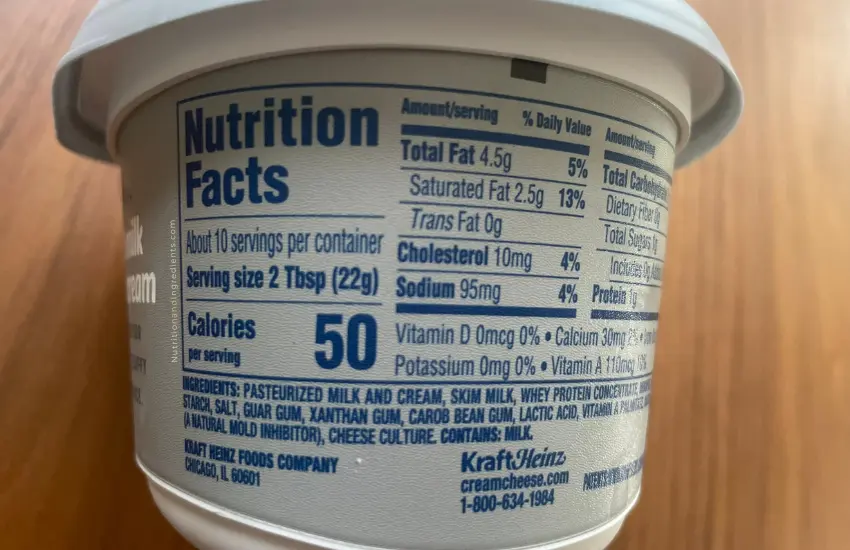
Ingredients
Butter is made with simple ingredients: fresh milk or cream. Salt and flavors may also be added.
Cream cheese contains half a dozen or more ingredients, depending on whether or not it’s a flavored spread.
Here is an informational table with the list of ingredients in each of the butter and cream cheese products we reviewed for this report.
Ingredients in Butter and Cream Cheese
|
Kerrygold Pure Irish Butter |
|
Pasteurized cream, Salt |
|
Land O’ Lakes Salted Butter |
|
Sweet cream, Salt |
|
Plugra Unsalted Butter |
|
Cream, Natural flavors |
|
Philadelphia Original Cream Cheese |
|
Pasteurized milk and cream, Salt, Carob bean gum, Cheese culture |
|
Philadelphia Whipped Cream Cheese (Garlic & Herb) |
|
Pasteurized milk and cream, Skim milk, Garlic puree (garlic, natural flavor), Whey protein concentrate, Modified food starch, Salt, Guar gum, Dried parsley, Xanthan gum, Carob bean gum, Lactic acid, Vitamin A palmitate, Natamycin, Cheese culture |
|
Philadelphia Whipped Cream Cheese |
|
Pasteurized milk and cream, Skim milk, Whey protein concentrate, Modified food starch, Salt, Guar gum, Xanthan gum, Carob bean gum, Lactic acid, Vitamin A palmitate, Natamycin, Cheese culture |
|
Publix Cream Cheese |
|
Pasteurized milk and cream, Cheese culture, Salt, Guar gum, Carob bean gum, Xanthan gum |
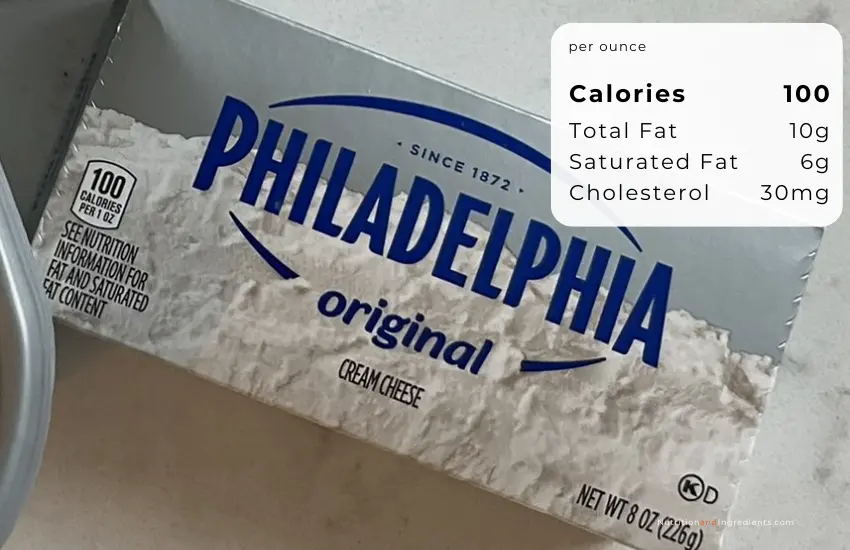
According to Kraft Heinz Foods, one of the largest consumer packaged goods companies in the world and the parent of the Philadelphia cream cheese brand, its original cream cheese spread contains no artificial preservatives, flavors, or food dyes.
Maintain a fresh tasting product by storing butter and cream cheese in the refrigerator. Cream cheese should be used within ten days of opening.
Nutritional Information
Before we dive into the nutrition information of butter and cream cheese, we need to ensure we have a comparable measurement.
Nutrition facts labels on butter indicate 100 calories per serving. However, that’s based on 14 grams, which is half the net weight used as the standard 1-ounce serving for nutrition facts labels on cream cheese.
Because food producers use different serving weights, we cannot rely on the labels to compare nutritional value. Rather, we start by converting the serving sizes.
Convert Serving Size
For a comparable analysis, we need to double the standard serving size and nutrients of butter. The reason is simple.
The standard serving size of cream cheese is 1 ounce. There are 28 grams per ounce.
A standard serving size of butter has 14 grams. So we need 28 grams (1 ounce) of butter to compare it to cream cheese.
Because we simply doubled the serving size (14 grams x 2 = 28 grams = 1 ounce), we also doubled the nutritional content. Hence, 100 calories per 14 grams is the same as 200 calories per 28 grams (1 ounce).
And now we can compare one ounce of butter to one ounce of cream cheese.
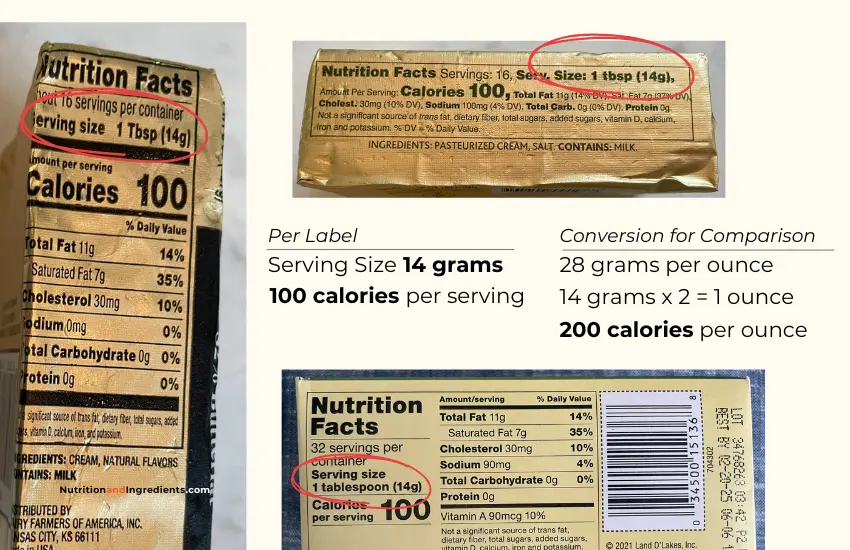
Calories
One main difference between butter and cream cheese is the amount of calories.
A one-ounce serving of butter has approximately 200 total calories. By comparison, cream cheese calories range from 65 to 100, depending on which variety is selected.
Whipped cream cheese, for example, has the lowest number of calories. One ounce contains about 65 total calories.
On the other hand, an ounce of Philadelphia cream cheese spread contains 100 calories per ounce.
Calories in Butter and Cream Cheese
|
Product |
Calories per Ounce |
|---|---|
|
Butter |
200 |
|
Philadelphia Original Cream Cheese |
100 |
|
Publix Regular Cream Cheese |
90 |
|
Whipped Cream Cheese |
65 |
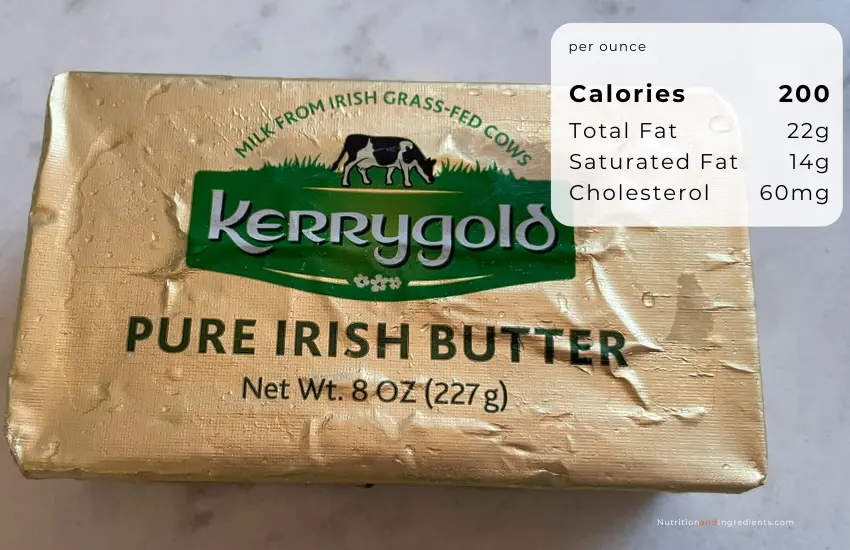
SUMMARY
Whipped cream cheese has the fewest calories. Butter has twice the amount of calories as regular cream cheese.
Nutrition Summary
When comparing these full-fat dairy products, butter comes out on top. It has twice the amount of fat compared to Philadelphia cream cheese spread.
Butter vs. Cream Cheese Nutrition Facts (1 Ounce)
Here is a comparison of the nutrition facts in one ounce of butter, regular cream cheese, and whipped cream cheese.
Comparison: Butter vs Cream Cheese
|
Serving Size: 1 Ounce |
Butter |
Cream Cheese |
Whipped Cream Cheese |
|---|---|---|---|
|
Calories |
200 |
100 |
65 |
|
Total Fat |
22g |
10g |
6g |
|
Saturated Fat |
14g |
6g |
3g |
|
Trans Fats |
0g |
0g |
0g |
|
Cholesterol |
640mg |
30mg |
13g |
|
Total Carbohydrates |
0g |
<1g |
3g |
|
Protein |
0g |
2g |
1g |
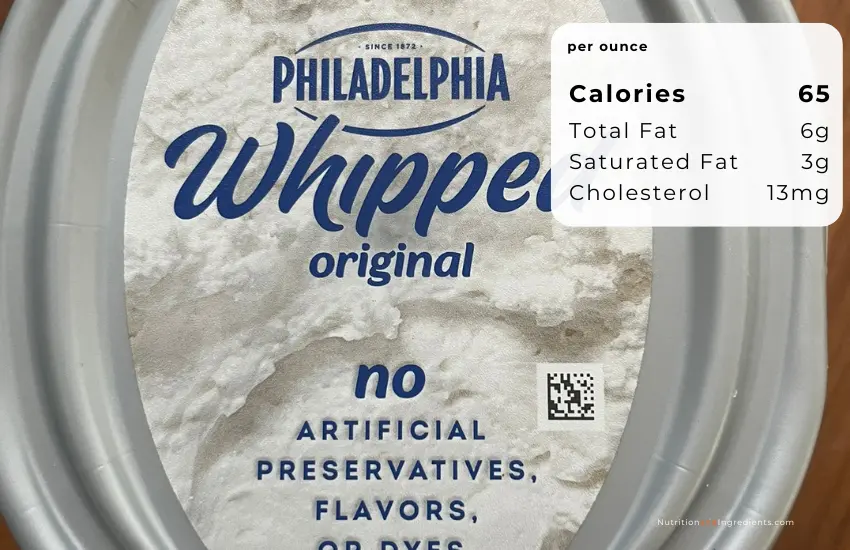
Of course, when cooking or planning meals, we generally don’t convert the measurements to compare to other condiments.
We simply want to know how many grams of fat, total calories, or sodium we are consuming.
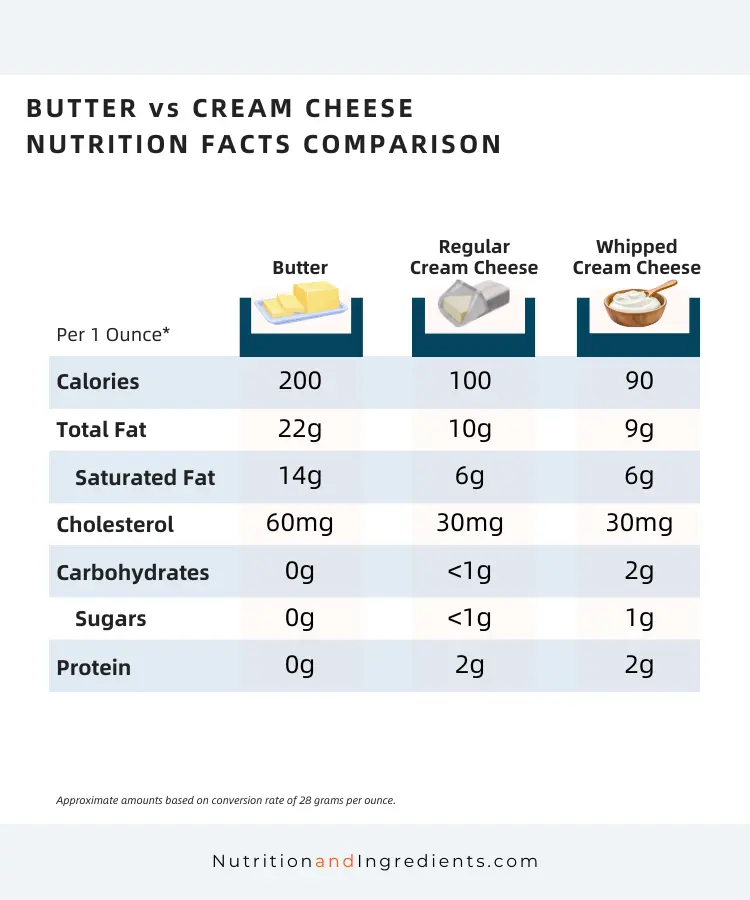
Butter Nutrition Facts (1 Tablespoon)
So, let’s bring it back to basics. A standard serving of butter is one tablespoon, or 14 grams, which delivers 100 calories. The 11 grams of total fat contribute 100% of the calories.
Here is a summary of the calories and nutrients in a single tablespoon of butter:
Butter
|
Serving Size: 1 Tablespoon (14g) | |
|---|---|
|
Calories |
100 |
|
Total Fat |
11g (14% DV) |
|
Saturated Fat |
7g (35% DV) |
|
Trans Fats |
0g |
|
Cholesterol |
30mg (10% DV) |
|
Total Carbohydrates |
0g (0% DV) |
|
Protein |
0g |
Butter is not a significant source of trans fatty acids, dietary fiber, sugars, vitamin D, calcium, iron, or potassium.
Cream Cheese Nutrition Facts (1 Ounce)
A standard serving of regular cream cheese is one ounce (28 grams). Kraft cream cheese (Philadelphia brand) is available in the cold dairy section at most grocery stores. It’s packaged in a rectangular block with 8 servings per container.
Ounce for ounce, cream cheese has less fat than butter.
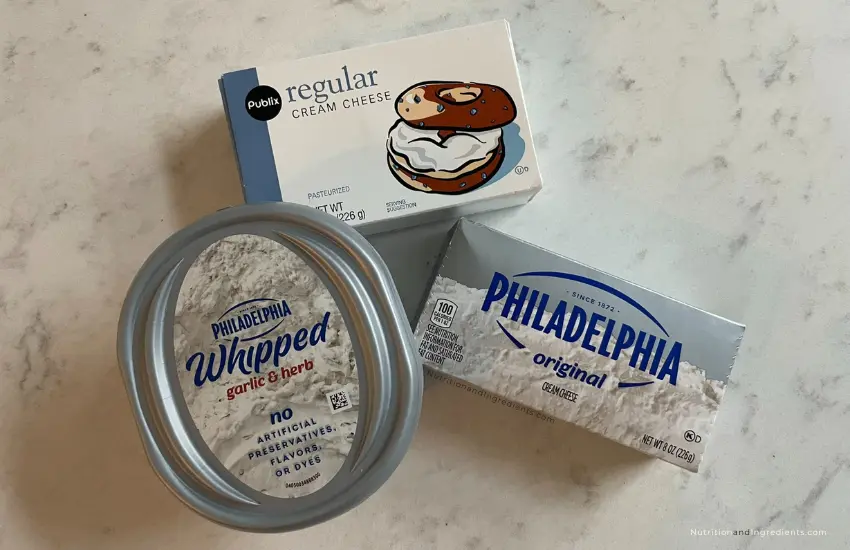
Here is a summary of the calories and nutrients in a serving of cream cheese:
Cream Cheese
|
Serving Size: 1 Ounce (28g) | |
|---|---|
|
Calories |
100 |
|
Total Fat |
10g (12% DV) |
|
Saturated Fat |
6g (29% DV) |
|
Trans Fats |
0g |
|
Cholesterol |
30mg (10% DV) |
|
Total Carbohydrates |
1g (0% DV) |
|
Protein |
2g |
FAQs
Here is some additional information with answers to commonly asked questions.

Any reference to daily value (%DV) is based on 2,000 calories. However, individual daily needs vary and your daily value may be higher or lower. Consult your physician to discuss your required calorie intake for a healthy way of life.
